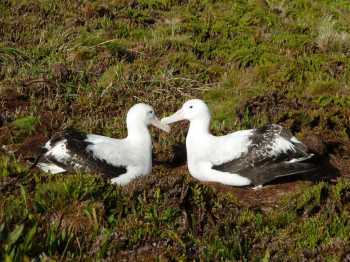The 2011 breeding season is proving to be no different. Only 90 chicks have survived winter in the three long-term demographic study sites on Gough to be banded this month, out of 209 eggs laid. Great albatrosses of the genus Diomedea would be expected to breed at a success of the order of 70-75%, so the 43% breeding success on Gough this year confirms that an attempt to eradicate the alien mice in the near future must remain a high priority.
A total-island count in September revealed only 353 chicks, down on last year's count of 406 (click here), and the second lowest since counts commenced, confirming poor breeding again over the whole island.

Research on ACAP-listed species on Gough Island is conducted jointly by the FitzPatrick Institute, University of Cape Town and the Royal Society for the Protection of Birds in the UK, with support from the UK's Overseas Territories Environment Programme and with the approval of the Tristan Conservation Department.
John Cooper, ACAP Information Officer, 22 September 2011, updated 30 September 2011

 English
English  Français
Français  Español
Español